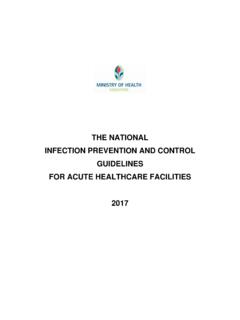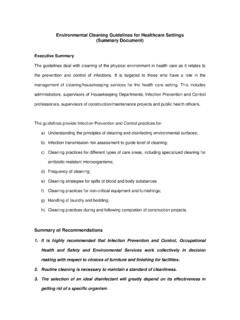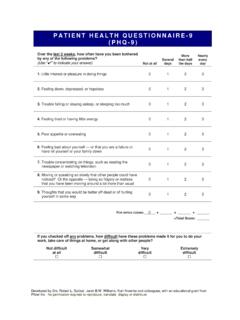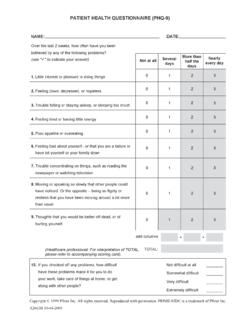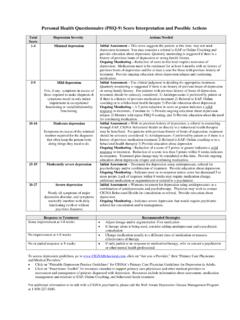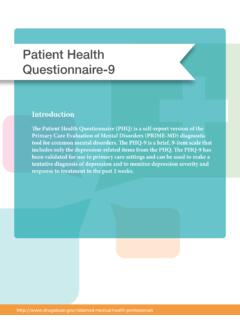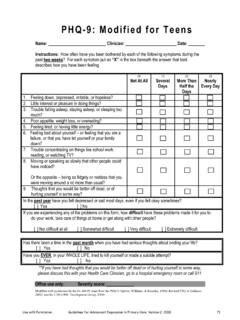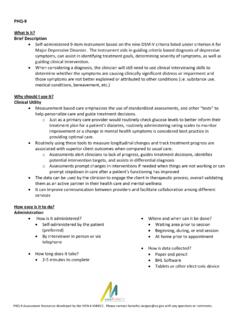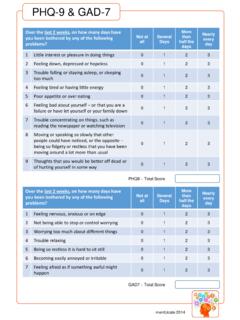Transcription of Depression - Ministry of Health
1 Depression Ministry of Health , SingaporeCollege of Medicine Building16 College RoadSingapore 169854 TEL (65) 6325 9220 FAX (65) 6224 1677 WEB 978-981-07-1411-6 MOH Clinical Practice Guidelines 1/20121+ + High quality meta-analyses, systematic reviews of randomised controlled trials (RCTs), or RCTs with a very low risk of bias 1+ Well conducted meta-analyses, systematic reviews of RCTs, or RCTs with a low risk of bias 1- Meta-analyses, systematic reviews of RCTs, or RCTs with a high risk of bias2+ + High quality systematic reviews of case control or cohort studies.
2 High quality case control or cohort studies with a very low risk of confounding or bias and a high probability that the relationship is causal 2+ Well conducted case control or cohort studies with a low risk of confounding or bias and a moderate probability that the relationship is causal 2- Case control or cohort studies with a high risk of confounding or bias and a significant risk that the relationship is not causal 3 Non-analytic studies, case reports, case series 4 Expert opinionA At least one meta-analysis, systematic review of RCTs, or RCT rated as 1+ + and directly applicable to the target population; or A body of evidence consisting principally of studies rated as 1+, directly applicable to the target population, and demonstrating overall consistency of resultsB A body of evidence including studies rated as 2++, directly applicable to the target population, and demonstrating overall consistency of results.
3 Or Extrapolated evidence from studies rated as 1+ + or 1+ C A body of evidence including studies rated as 2+, directly applicable to the target population and demonstrating overall consistency of results; or Extrapolated evidence from studies rated as 2+ +D Evidence level 3 or 4; or Extrapolated evidence from studies rated as 2+ Recommended best practice based on the clinical experience of the guideline development group.(good practice points)Grades of recommendationLevels of evidenceType of EvidenceLevelGradeRecommendation Levels of evidence and grades of recommendationGPP13 CLINICAL PRACTICE GUIDELINES Depression MOH Clinical Practice Guidelines 1/201224 Published by Ministry of Health , Singapore 16 College Road, College of Medicine Building Singapore 169854 Printed by Oxford Graphic Printers Pte Ltd Copyright 2011 by Ministry of Health , Si ngapore ISBN 978 981-07-1411-6 Available on the MOH website.
4 Statement of Intent These guidelines are not intended to serve as a standard of medical care. Such standards are determined on the ba sis of all clinical data available for an individual case and are subject to change as scientific knowledge advances and patterns of care evolve. The contents of this pu blication are guidelines for clinical practice, based on the best available evidence at the time of de velopment. Adherence to these guidelines may not ensure a successful outcome in every case. These guidelines should neither be construed as including all pr oper methods of care, nor excl ude ot her acceptable methods of care.
5 Each physician is ultimately responsible for the management of his/her unique patient, in the light of the clinical data presented by the patient and the diagnostic and treatment options available. 14 Published by Ministry of Health , Singapore 16 College Road, College of Medicine Building Singapore 169854 Printed by Oxford Graphic Printers Pte Ltd Copyright 2011 by Ministry of Health , Si ngapore ISBN 978 981-07-1411-6 Available on the MOH website: Statement of Intent These guidelines are not intended to serve as a standard of medical care.
6 Such standards are determined on the ba sis of all clinical data available for an individual case and are subject to change as scientific knowledge advances and patterns of care evolve. The contents of this pu blication are guidelines for clinical practice, based on the best available evidence at the time of de velopment. Adherence to these guidelines may not ensure a successful outcome in every case. These guidelines should neither be construed as including all pr oper methods of care, nor excl ude ot her acceptable methods of care.
7 Each physician is ultimately responsible for the management of his/her unique patient, in the light of the clinical data presented by the patient and the diagnostic and treatment options available. 5 Contents Page Executive summary of rec ommendations 1 31 noitcudortnI 1 61 noitaulave lacinilC 2 32 tnemtaert fo selpicnirP 3 62 yparehtocamrahP 4 43 yparehtohcysP 56 Psychoeducation and family intervention 38 04 ypareht evisluvnocortcelE 78 Depression in children and adolescents 43 74 ycnangerp ni noisserpeD 9 05 ylredle ni noisserpeD 01 53 seussi ssenevitceffet-soC 11 55 tnemevorpmi ytilauq lacinilC 21 Annex I - Factors associated with Depression 56-57 Annex II - Assessment of suicide risk 58 Annex II I Sc reening tools
8 For de pressive disorders 59-61 Annex IV - Fl ow chart for pharmacotherapy of major depressive disorder 62 Annex V - Pharmacologic classes of antidepressants 63 Annex VI - Recommendations to switching antidepressants 64-66 Annex VII Clinical Global Impression (CGI) scale 67 28-86 secnerefeR 38 )sQCM( tnemssessa-fleS 58 srebmem puorgkroW 26 Foreword Depression is a major Health problem which impairs psychosocial and occupational functioning, and is associated with significant morbidity and mortality. In the 2004 Global Burden of Disease Study, Depression was found to be the third leading cause of burden of disease worldwide and the top leading cause of burden of disease in middle and high income countries.
9 * Likewise, Depression is a major Health problem in Singapore, with the 2010 Singapore National Mental Health Survey reporting a lifetime prevalence of Depression in the Singapore adult population. The first edition of the MOH clinical practice guidelines on Depression was published in 2004 to provide evidence-based guidance for the management of patients with Depression . This second edition of the guidelines updates and expands the first edition with new evidence. Screening and diagnostic instruments are discussed in greater detail, and a new section providing guidance on the management of Depression in pregnant patients has been added.
10 I hope that this set of guidelines will be able to assist people with Depression and all healthcare professionals that care for them. PROFESSOR K SATKU DIRECTOR OF MEDICAL SERVICES _____ *World Health Organization. The global burden of disease: 2004 update. 2008 [cited 2011 Oct 20]. Available from: disease/2004_report_update/en/ 16 Foreword Depression is a major Health problem which impairs psychosocial and occupational functioning, and is associated with significant morbidity and mortality. In the 2004 Global Burden of Disease Study, Depression was found to be the third leading cause of burden of disease worldwide and the top leading cause of burden of disease in middle and high income countries.

